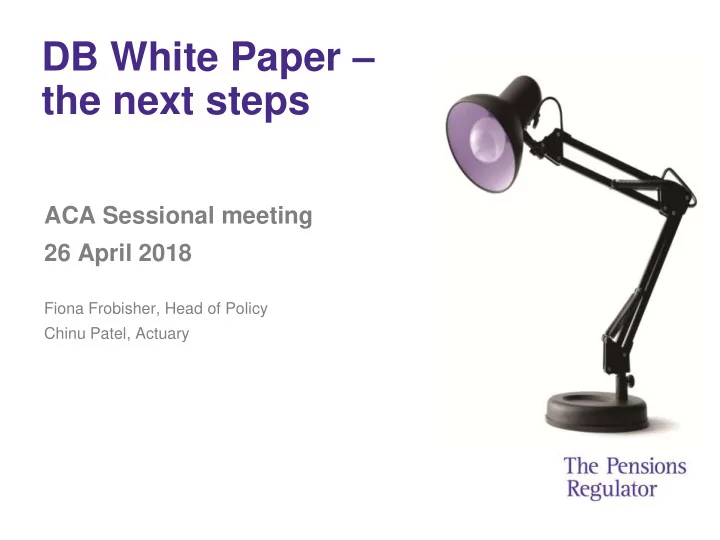

DB White Paper – the next steps ACA Sessional meeting 26 April 2018 Fiona Frobisher, Head of Policy Chinu Patel, Actuary
Outline • Overview of the DB White Paper proposals • What happens next • A closer look at funding • Questions
DB: White paper on sustainability of schemes TPR to be provided with the ‘right powers to do its job’ Protecting occupational • Pensions New powers to punish wrong doing • Information gathering powers Scheme Consolid- Funding ation • Revised funding code with new emphasis • Authorisation regime
DB White Paper recommendations – TPR powers Strengthen the regulatory framework and guard against the small minority of employers content to put their scheme at risk. • Punitive fines • Criminal offence “ wilful or grossly reckless behaviour in relation to a pension scheme” • Strengthen the existing notifiable events framework and voluntary clearance regime • Harmonise and improve the Regulator’s information-gathering powers
DB White Paper recommendations – Scheme funding Aim to keep the flexible elements of current framework but address weaknesses. • Revised funding code focusing on: how prudence is demonstrated when assessing scheme liabilities; what factors are appropriate when considering recovery plans; and ensuring a long-term view is considered when setting the Statutory Funding Objectives. • Chair’s Statement , submitted with the scheme’s triennial valuation. • Legislative tweaks • DWP/TPR will also review the RAA framework.
DB White Paper recommendations – Consolidation DWP looking to raise awareness of existing forms of consolidation and facilitate market entry of new vehicles through appropriate safeguards. DWP will – Consult on an authorisation regime for new forms of consolidations vehicles – Consult on an accreditation regime for existing forms of consolidation (eg. master trusts, asset pooling, shared services, fiduciary management) – Work with TPR to raise awareness of benefits of consolidation – Consider legislative change to support limited benefit simplification – Explore developing collective defined contribution schemes
Review of the DB framework DWP consults Autumn 18 ? Pensions Bill 2019 ? The Dev. Draft Code Spring Code Summer Autumn next 2020 code consult made Policy 19 19 year • Extensive engagement across industry • Open policy making (DBchange@tpr.gov.uk) • Keen to explore range of options • Industry working group
A closer look at scheme funding
Scheme funding: The key issues • Trustee decision-making and risk management does not always reflect good practice and the principles set out in TPR’s funding code • Perception of short term focus instead of strategic thinking about long-term desired outcomes • Concern about lack of accountability and transparency • Lack of clear definition makes proving non-compliance and enforcement difficult, time consuming and costly
Scheme funding proposals (1) Trustees and sponsors to agree a long term objective (LTO), and embed it in their statutory funding objective Examples of LTO could be to: run-on with employer support (for open schemes); reach self-sufficiency with low-risk investment strategy and run-off with minimal call on the employer; buy-out by a set time; or enter a consolidator vehicle within an agreed timeframe. Others? What do you come across in practice? Current funding requirements (SFO, TPs, RPs) remain but will be linked to LTO. Triennial valuations viewed as staging posts towards the LTO LTO becomes a baseline against which scheme performance gets measured Formalisation of what many schemes already do?
Scheme funding proposals (2) Provide more clarity on DB funding standards to ensure better compliance and strengthen TPR’s enforcement capability By providing practical definitions of: how prudence is demonstrated when assessing scheme liabilities; what factors are a ppropriate when considering recovery plans; and ensuring a long-term view is considered when setting the Statutory Funding Objective. How? Some form of model driven probabilities? A focus on outcomes and things that can happen to de-rail them? Something else?
Scheme funding proposals (3) A DB Chair Statement, submitted with the scheme’s triennial valuation. We expect this to become a key component of ‘do and show’ by trustees. Key ingredients could be: What’s your chosen LTO and the rational behind it? What’s your management plan for reaching it? How robust is that plan? How good are you at keeping to the plan? But DWP has positioned it as a management tool first, for good reason: Schemes may report to TPR every 3 years, but they are expected to be practising what they say they do all the time. Telling TPR what they’ve done should follow as a by -product.
Scheme funding proposals (4) A new funding Code with clearer funding standards Which will Put onus on trustees and sponsors to prove compliance Designed to make enforcement quicker and more effective DWP will legislate to require trustees and employers to comply with some or all of it and if necessary make changes to s231 to enable enforcement. Bring about some behavioural changes to improve and demonstrate quality of scheme management. Current TPR reporting requirements may not sit well with the White Paper proposals – we will streamline them.
Any questions?
Recommend
More recommend